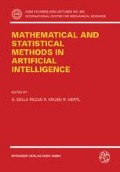Abstract
Impreciseness and vagueness are facets of uncertainty and mean that an object or some of its features can not be recorded or described precisely. Hence both must be considered in contrast with randomness, which describes variability, being another kind of uncertainty. Whereas probability theory and mathematical statistics deal with the behaviour of (perhaps hypothetical) populations, impreciseness and vagueness are concerned with each single piece of information, called a datum. For handling such data they must be described as mathematical items. The “classical” model for impreciseness is given by set-value-description, e.g. by intervals in the simplest case. However, as is known, the main problem in application of interval mathematics is fixing precise ends of the intervals. Moreover, data can be given by verbal descriptions. Then they are called vague data, usually coded by numbers or letters. However, in such a form they lose much of their semantic meaning, which would be very important for processing them and for interpreting the conclusions drawn from this processing. In the paper some examples are provided how such imprecise or vague data had been specified by fuzzy sets in real-world applications, e.g. measuring from blurred pictures in the micro area and comparing imprecise sample-spectrograms with standard spectrograms. Methods included are, e.g., using grey-tone levels in pictures on the screen and using structure elements from mathematical morphology for specifying fuzzy functions. Finally a numerical example is considered to show how impreciseness influences the results of simple statistical procedures.
Access this chapter
Tax calculation will be finalised at checkout
Purchases are for personal use only
Preview
Unable to display preview. Download preview PDF.
References
Bandemer, H. (Ed.): Modelling Uncertain Data. Akademie Verlag, Berlin 1993
Bandemer, H.; Bellmann, A.: Unscharfe Methoden der Mehrphasenregression. In: Peschel, G. (Ed.): Beiträge zur Mathematischen Geologie und Geoinformatik, Sven von Loga, Köln, 1991, 25–27.
Bandemer, H.: Fuzzy data: the “Likeness” of individuals. Genealogical Computing 10 (1990), 47.
Bandemer, H.; Gottwald, S.: Introduction to Fuzzy Methods. Wiley, Chichester, 1995
Bandemer, H.; Kraut, A.: On a fuzzy-theory-based computer-aided particle shape description. Fuzzy Sets and Systems 27 (1988), 105–113
Bandemer, H.; Kraut, A.: A case study on modelling impreciseness and vagueness of observations to evaluate a functional relationship. In: Janko, M.; Roubens, M.; Zimmermann, H.-J., (Eds.): Progress in Fuzzy Sets and Systems, Kluwer Academic Publ., Dordrecht, 1990, 7–21
Bandemer, H.; Kraut, A.: On fuzzy shape factors for fuzzy shapes. In: Bandemer, H. (Ed.): Some Applications of Fuzzy Set Theory in Data Analysis II, Freiberger Forschungshefte D 197, Grundstoffverlag Leipzig, 1989, 9–26
Bandemer, H.; Kraut, A.; Vogt, F.: Evaluation of hardness curves at thin surface layers–A case study on fuzzy observations–In: Bandemer, H. (Ed.): Some Applications of Fuzzy Set Theory in Data Analysis; Freiberger Forschungshefte D 187, Grundstoffverlag, Leipzig 1988, 9–26
Bandemer, H.; Näther, W.: Fuzzy Data Analysis. Kluwer Academic Publishers, Dordrecht, Boston, London 1992.
Bandemer, H.; Roth, K.: A method of fuzzy-theory-based computer-aided data analysis. Biom. J. 29 (1987), 497–504
Bocklisch, St. F.: Prozeanalyse mit unscharfen Verfahren. Verlag Technik, Berlin 1987
DiGesù, V.; Maccarone, M. C.; Tripiciano, M.: MMFUZZY: Mathematical morphology based on fuzzy operators. In: Lowen, R.; Roubens, M. (Eds.) Proc. IFSA 91, Brussels, Engineering, 1991, 29–32.
Goodman, I. R.; Nguyen, H. T.: Uncertainty Models for Knowledge-Based Systems. North-Holland Publ. Comp., Amsterdam 1985
Kruse, R.; Meyer, K.D.: Statistics with Vague Data. Reidel Publishing Company, Dordrecht 1987.
Kruse, R.; Gebhardt, J.; Klawonn, F.: Fuzzy-Systeme. B.G. Teubner Verlag, Stuttgart 1993
Malinvaud, E.: Statistical Methods Of Econometrics. North-Holland, Amsterdam 1966
Nagel, M.; Feiler, D.; Bandemer, H.: Mathematische Statistik in der Umwelttechnik. In: Bandemer, H. (Ed.): Mathematik in der Technik, Bergakademie Freiberg 1985, Heft 1, 61–66
Otto, M.; Bandemer, H.: Pattern recognition based on fuzzy observations for spectroscopic quality control and chromographic fingerprinting. Ana. Chim. Acta 184 (1986), 21–31
Otto, M.; Bandemer, H.: A fuzzy approach to predicting chemical data from incomplete, uncertain and verbal compound features. In: Jochum, C.; Hicks, M.G.; Sunkel J. (Eds.): Physical Property Prediction in Organic Chemistry, Springer Verlag, Berlin, Heidelberg 1988, 171–189
Serra, J.: Image Analysis and Mathematical Morphology; Vol. 2, Academic Press, Princeton, 1988.
Viertl, R.: Statistical inference for fuzzy data in environmetrics. Environmetrics 1 (1990), 37–42
Viertl, R.: Einführung in die Stochastik. Springer Verlag Wien, New York 1990
Viertl, R.: On statistical inference based on non-precise data. In: Bandemer. H. (Ed.): Modelling Uncertain Data, Akademie Verlag, Berlin 1993, 121–130
Wang, Z.; Klir, J.: Fuzzy Measure Theory, Plenum Press, New York 1992.
Author information
Authors and Affiliations
Editor information
Editors and Affiliations
Rights and permissions
Copyright information
© 1995 Springer-Verlag Wien
About this paper
Cite this paper
Bandemer, H. (1995). Fuzzy Specification of Uncertain Knowledge and Vague or Imprecise Information. In: Della Riccia, G., Kruse, R., Viertl, R. (eds) Proceedings of the ISSEK94 Workshop on Mathematical and Statistical Methods in Artificial Intelligence. International Centre for Mechanical Sciences, vol 363. Springer, Vienna. https://doi.org/10.1007/978-3-7091-2690-5_1
Download citation
DOI: https://doi.org/10.1007/978-3-7091-2690-5_1
Publisher Name: Springer, Vienna
Print ISBN: 978-3-211-82713-0
Online ISBN: 978-3-7091-2690-5
eBook Packages: Springer Book Archive

